
 |
|
|
#1 |
|
All the news that's fit to excerpt
Name: newsie
Location: who knows?
Join Date: Jun 2008 Motorcycle(s): only digital replicas Posts: Too much.
|
[cycleworld.com] - Sachsenring MotoGP Report
Kevin Cameron deconstructs the 2022 German MotoGP and how the fast get faster.
Click here to view on their site. 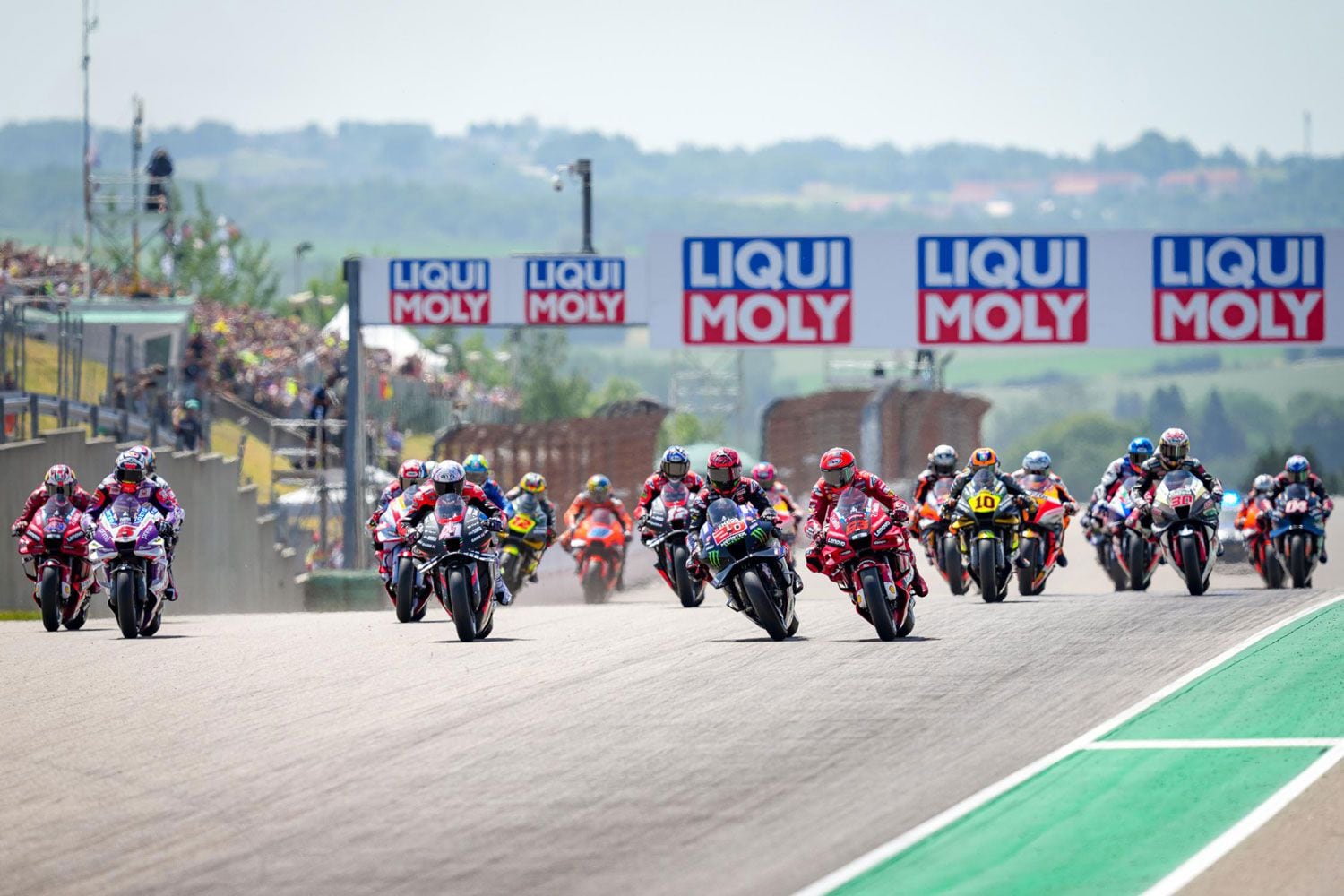 Despite a slew of Ducatis up front at the start, Fabio Quartararo led nearly every second of the Sachsenring MotoGP. (MotoGP/)Early in the weekend there was a swarm of Ducatis up front at the German GP, making it seem like there might indeed be some value in having eight bikes on the grid after all. If you have one star rider, the others can in potential act as “point spacers,” getting between the star and his pursuers. And just as at Barcelona two weeks ago, there was Fabio Quartararo, the championship point leader, not particularly fast in early practice. Meanwhile, Francesco Bagnaia set a new lap record Friday in FP2 on his factory Ducati. He would set it again Saturday morning, lowering it to 1:19.765. Also interesting was Jack Miller’s account of what his team learned in the post-Barcelona test: basically, that he needed to put his own mass farther forward on the bike. This is a very old lesson, often repeated. Velocette learned it in 1935 when, in back-to-back tests, it was surprised to find weight forward made rider Stan Woods faster. When Peter Doyle came on as crew chief at Yoshimura US, during one day test he wordlessly taped seat padding on Mat Mladin’s Suzuki, pushing him 3 inches forward. The result? Four-tenths a lap better. If that seems unimportant, multiply it by 25 laps—10 seconds. Miller said, “I’d been suffering a lot from the beginning of the year really to get the bike stopped, so we shifted my riding position at the test, moved my handlebars forward quite a bit. I immediately felt like I had some more confidence in the front of the bike, especially here, where it’s all about turning.” Getting a Grip More confidence in the front of the bike! What US race engineer Erv Kanemoto learned from building his adjustable-front-end TZ250 Yamaha in 1977 is that front grip comes only from load, and not from rake, trail, or King Arthur in his cave by the sea. The matter had already been decided, however. In line with its recent policy of putting hot young talent on its bikes, Ducati has moved Miller out. He’ll be riding a KTM next year. Aleix Espargaró bettered Bagnaia’s new lap record Saturday morning, then qualified fourth on the fast-turning Aprilia after having been the only non-Ducati in the top six Friday. And from FP2 on, Quartararo began to find speed. What if there is not strength in numbers? Choice of tires fell between medium and hard for the rear. Reading from the Michelin brochure we find that the medium offers more initial grip but less stability, while the hard moves around less. Riders wrestled with this, knowing Sunday would be hotter than the already hot Saturday. What can Sunday morning warmup tell a team about what will happen in the heat of the day? 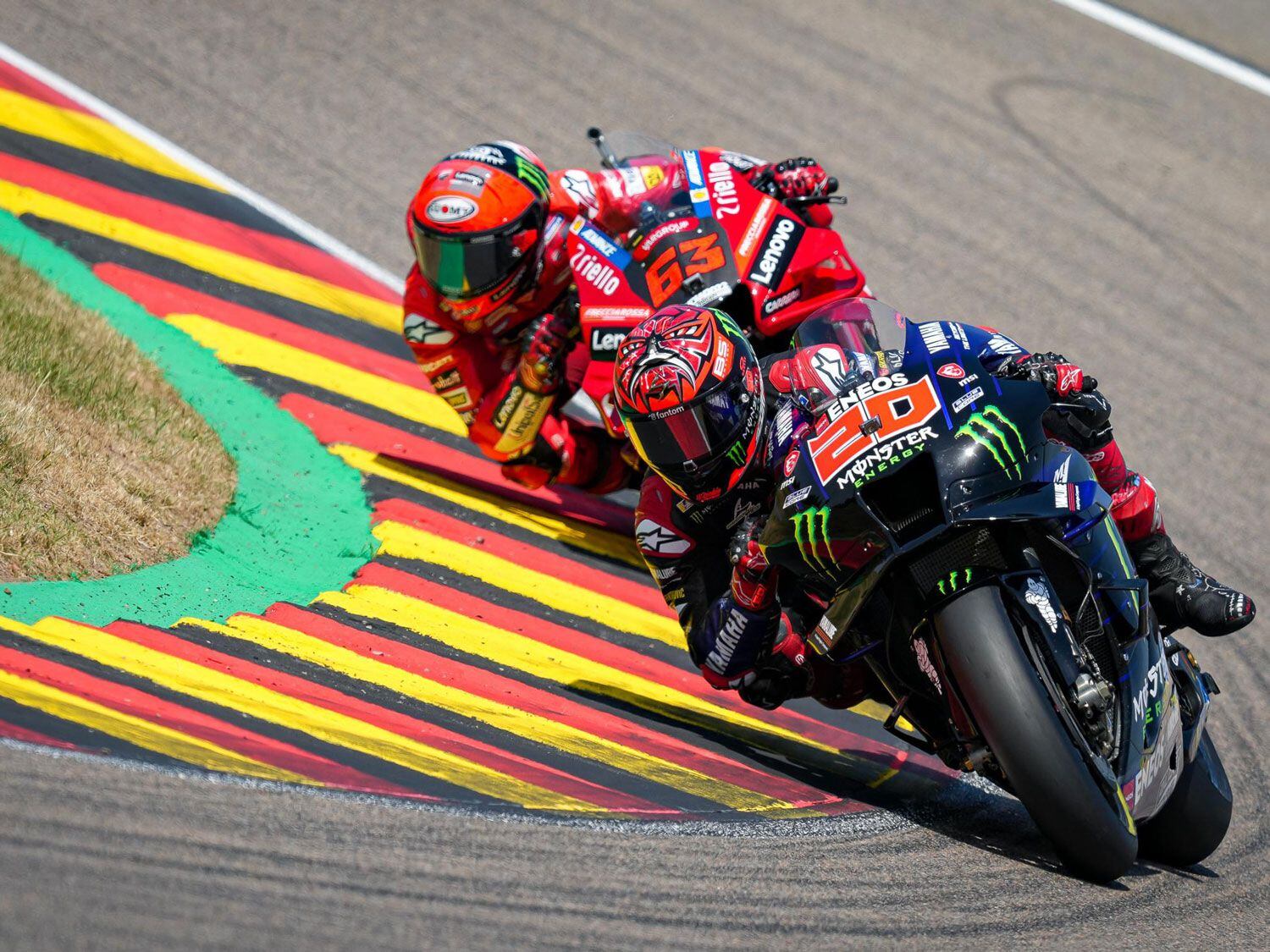 Quartararo’s decision to run a medium rear allowed him to push early. (MotoGP/)Bagnaia had said, “I’ve been feeling great since the first practice session. By Friday I had everything I needed and in fact I have not changed anything on the bike.” Tire choice? “It won’t be easy…the medium has more potential but drops more, and the hard is the opposite plus it doesn’t take much to destroy the rear.” How do riders deal with this? Luca Marini (part of Ducati’s hot young talent collective) said, “We all go with little power, even for the time attack.” This is the MotoGP equivalent of clicking your high-power streetbike to rain mode. Marini continued, “…here you need to have a good connection with the gas and not stress the tire. Even with new tires you can’t push, so you have to go easy on the power and the engine-braking so as not to stress them too much.” On Sunday “…it will be warmer so we will all go slower. We will see who will adapt better.” Espargaró refined this further, joking that, “On the right side [of the rear tire] I can do the 24 hours of Le Mans.” (This is because Sachsenring is a left-hand course with very few rights.) “…the problem is the left. You are spending a lot of time spinning, spinning, spinning. So the temperature of the shoulder of the tire gets very high.” Bagnaia, asked about his race plan, said, “…if I find myself in the lead, I will push, and if I am second, I will try to overtake as soon as possible whoever I have in front to do my own race.” Adding meaning to Marini’s remarks, Bagnaia said on Saturday, “Today I tried to push with the new tire but the drop was greater than yesterday, and tomorrow it will be even hotter.” Managing Tire Drop “Drop” here refers to the drop in tire properties expected after a number of racing laps, usually accelerated by higher tire temperature. Because such changes occur in tires, we can think of the race itself as a poker game in which certain cards in your hand may at any time catch fire. The front row was Bagnaia on pole, Quartararo second, Johann Zarco (Ducati) third, with Espargaró heading the second row. Quartararo was first into turn 1 with Bagnaia right there, and Q’s Yamaha had its rear tire in the air as they braked. “…at the first corners I threw myself in to be first.” Bagnaia, true to his strategy, attacked immediately, but the pass attempt took him high, and Quartararo came back under him. Then on lap 4 Bagnaia, in his words, “turned around”—he spun out. “At the first touch [of acceleration] I turned around, like a Moto2 bike in the wet.” The data “…shows that I had accelerated more smoothly than usual. “I was turning more for the exit [a wider line?], so it’s very difficult to understand why I crashed.” 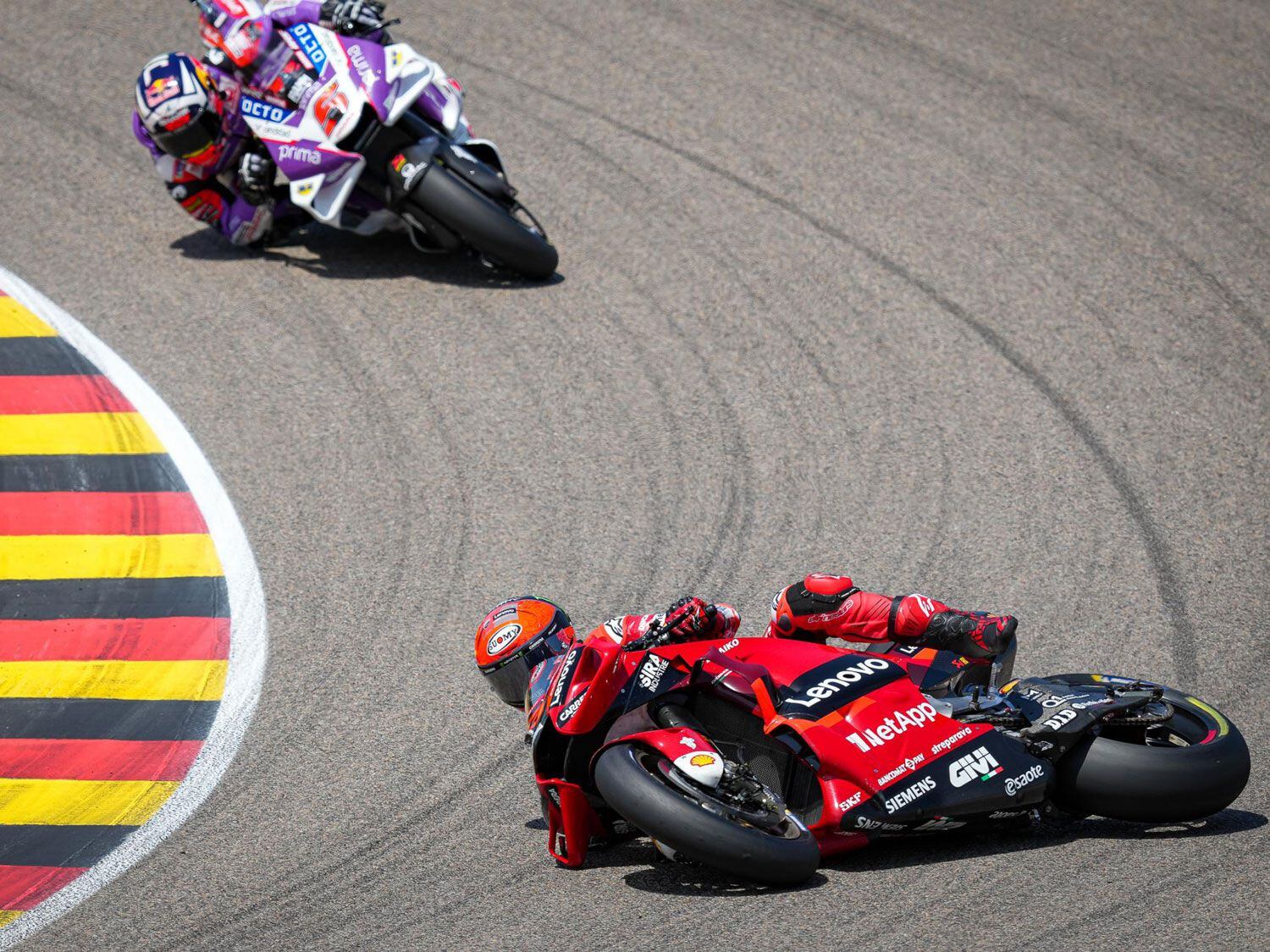 Pecco Bagnaia lost the rear on the fourth lap—a third DNF in four races. (MotoGP/)The established racing line offers the most grip. Who knows? Quartararo was one of only two riders who ran the medium rear. “With the medium tire this morning I felt it was the correct choice because with 27 laps [on that tire] I was doing low 1:22s. “…from the beginning I was a little bit scared because I was using the tire a little bit more than I expected, to ride fast. “When [I saw I had a] one-second advantage I started to control, not push too hard. “I [sped up] only when Zarco got closer.” Zarco said, “Fabio was so, so constant. I was losing time to him, but in trying to follow [him] I got a big advantage to second place.” Zarco’s recent strong finishes make me suspect he is getting useful benefit from training himself to use the variable ride height system constantly. On Saturday several riders had predicted that the last 10 of the 30 laps would be high risk. Quartararo said, “The last five-six laps were a total disaster from the rear, but the feeling on the front was super good.” Zarco’s view: “The last laps were like a nightmare to try and control the bike.” 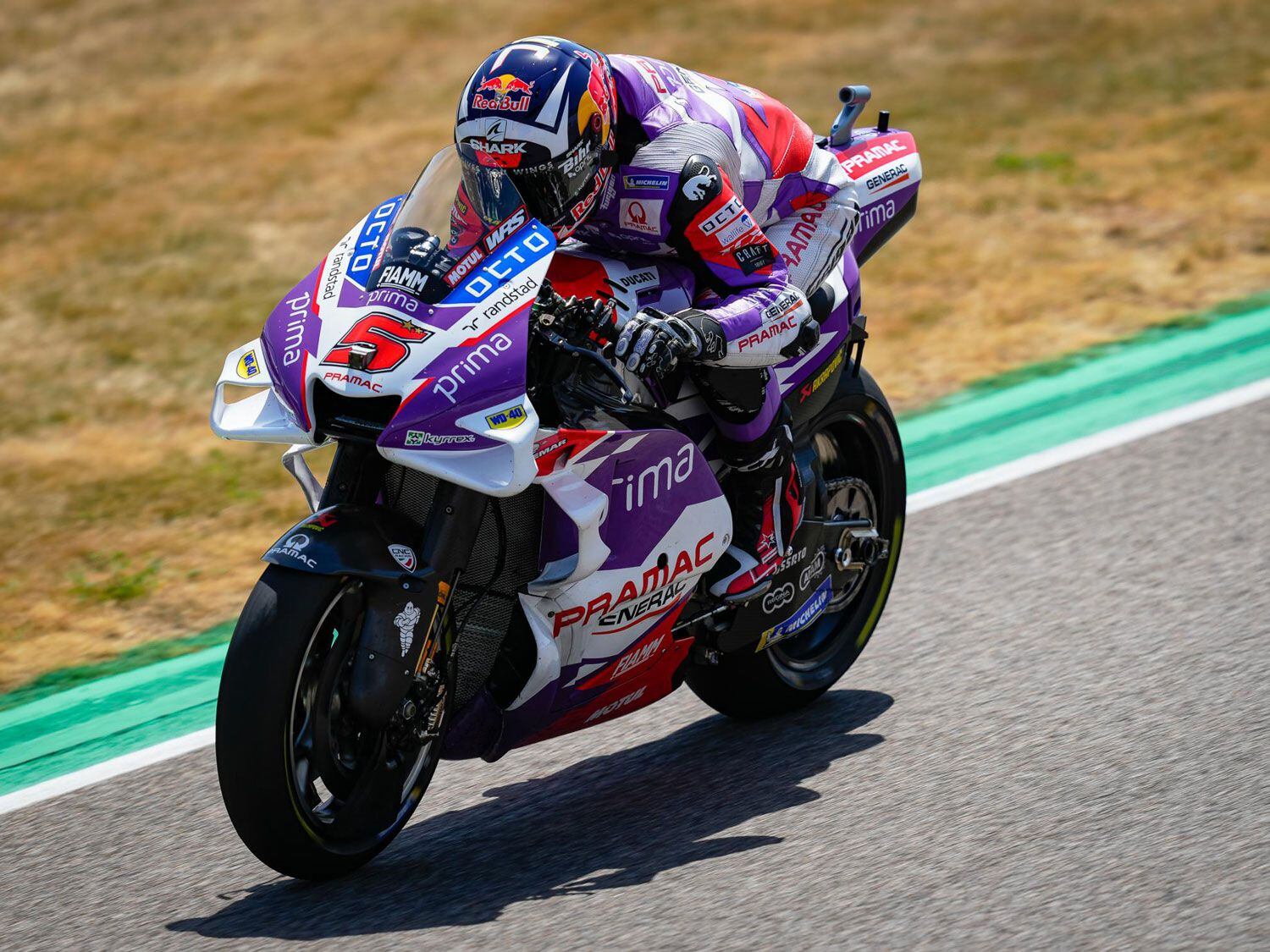 Johann Zarco finished second at Sachsenring. (MotoGP/)Maverick Viñales had surprised everyone by running fourth on the Aprilia he had lately been insisting must be adapted to his riding style. Late in the race his rear ride height device went to its low position and stayed there, forcing his retirement and handing Miller fourth. Miller then took advantage of a late mistake by Espargaró to finish third. 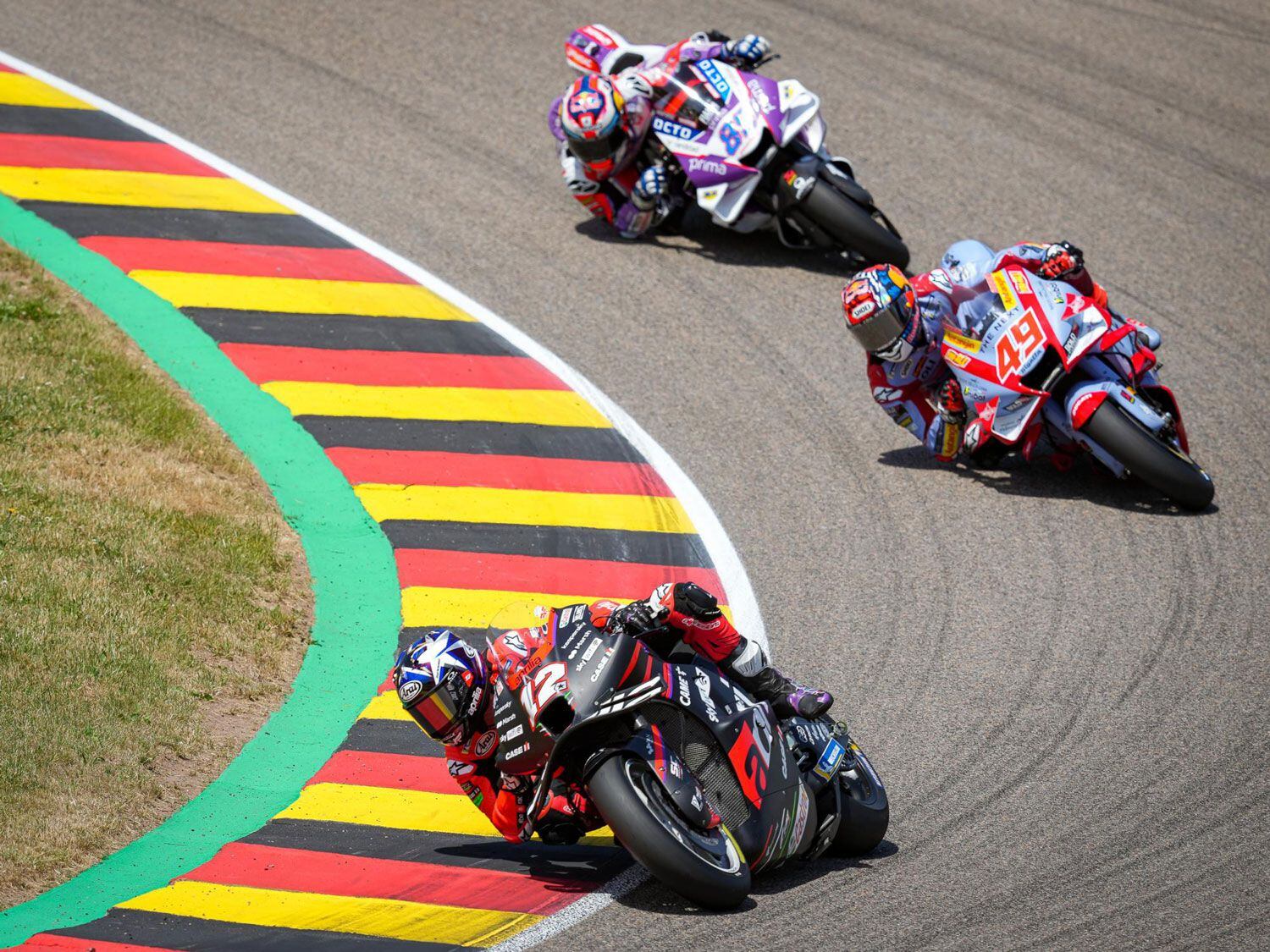 Maverick Viñales was just outside of the top three and looked to be adapting well to the conditions at Sachsenring. Then the automatic ride-height adjustment on this Aprilia failed, taking him out of the race. (MotoGP/)With crashes and retirements, only 16 of 23 bikes finished. Stefan Bradl, standing in for recovering Marc Márquez, revealed that engine heat from his Honda had burned his right hand and one foot. Espargaró had changed his front tire on the start grid, and by turn 1 knew it was vibrating. Soon he was fearful that parts might fly off his bike, but he persevered. Because Quartararo seems uncertain of a good result early in these weekends, then goes faster as the track “rubbers up,” he seems surprised by his wins. Yet as others comment, his consistency in the races shows that he is not “dicing with death out there,” going fast by taking one big risk after another. I am getting the feeling that he has deciphered some of the signal traffic coming from his tires. Just “going easy on the tires” makes a rider slow, but Quartararo is fast. Many riders have spoken of such signals. American vintage racer Todd Henning, pursuing a rival, waited until he saw some unspecified change in the appearance of that rider’s rear tire, indicating that it was finished. He would then launch a pass, and it would succeed. Another rider spoke of tire sounds or tire vibration, that there were “good traction sounds” and bad ones, the latter indicating “Don’t do that once too often.” But when I asked Gary Nixon about this, he said simply, “I got them earplugs in. I don’t hear nothin.’” Understanding—the Key to Speed In general, I have seen that the dominant rider in any given era is the one who has uniquely understood and exploited something new that is available to all. Kenny Roberts saw that the harsh acceleration of two-stroke racebikes made it impossible to steer with the front, so he steered with the rear, using the throttle. Freddie Spencer had learned on dirt tracks how to recover lost front grip with the throttle, so he tried it on pavement. It worked, and gave him a unique ability to go in deep and accelerate early. Márquez brought a refined tire conservation riding style from Moto2 to MotoGP. The American dirt-track rider-engineer Albert Gunter told his acolyte, Dick Mann, “You’ll never beat these guys using what they do—they’ve all got way more experience with that than you have. You need an edge that only you have. Something new.” This conflicts with the time-worn view that top riders fade when their trophy shelves are full and they’ve lost their drive. Younger, hungrier men, eager to gobble risk in pursuit of victory, push them aside. 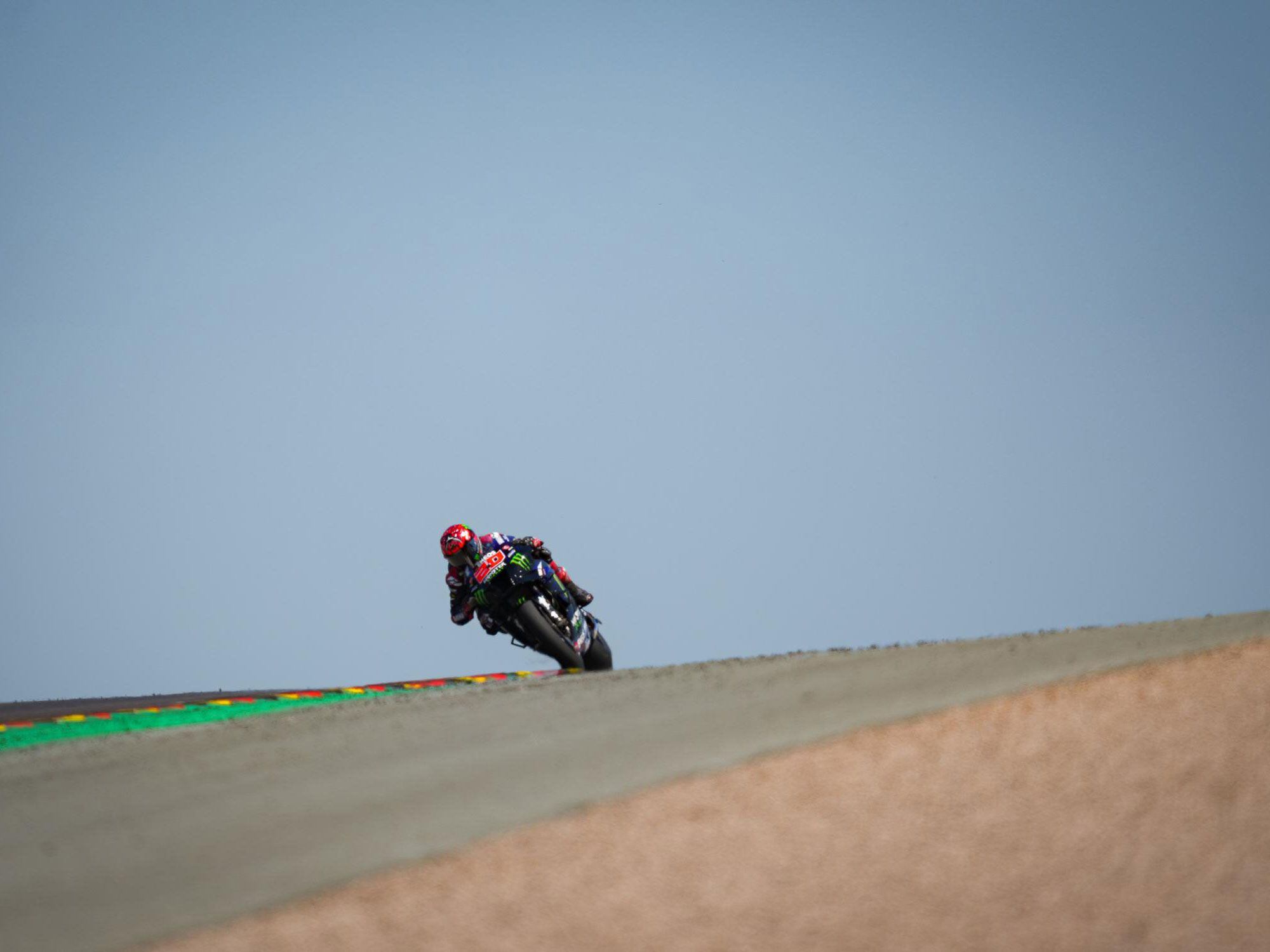 Quartararo has learned something new. (MotoGP/)No. The fact is that going faster is not the result of “riding harder.” That just leads to erratic lap times and mistakes that grow in consequence until the rider falls. To go faster, you must learn something new. I believe Quartararo has.
__________________________________________________
I'm a bot. I don't need no stinkin' signature... |
|
|

|
 |
 Similar Threads
Similar Threads
|
||||
| Thread | Thread Starter | Forum | Replies | Last Post |
| [cycleworld.com] - Catalunya MotoGP Report | Ninjette Newsbot | Motorcycling News | 0 | June 7th, 2022 01:51 PM |
| [cycleworld.com] - 2022 Mugello MotoGP Report | Ninjette Newsbot | Motorcycling News | 0 | May 31st, 2022 02:43 PM |
| [cycleworld.com] - 2022 Le Mans MotoGP Report | Ninjette Newsbot | Motorcycling News | 0 | May 17th, 2022 02:53 PM |
| [cycleworld.com] - 2022 Portimão MotoGP Report | Ninjette Newsbot | Motorcycling News | 0 | April 25th, 2022 04:02 PM |
| [cycleworld.com] - 2022 Grand Prix of the Americas MotoGP Report | Ninjette Newsbot | Motorcycling News | 0 | April 20th, 2022 11:52 AM |
| Thread Tools | |
|
|